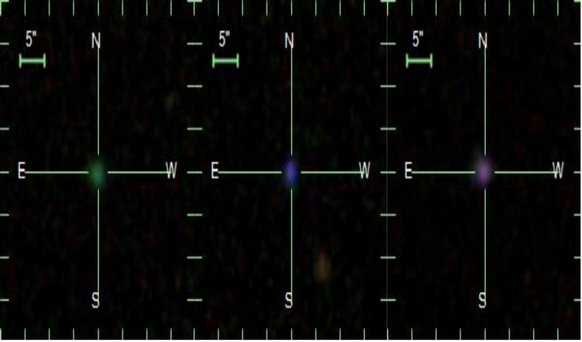Extragalactic fruit and vegetable garden: compact galaxies discovered by LAMOST
A research team of Chinese astronomers led by PhD student Siqi Liu and Prof. A-Li Luo from the National Astronomical observatories of the Chinese Academy of Sciences (NAOC), together with Prof. Jun-Xian Wang from University of Science and Technology of China (USTC) and Prof Shi-Yin Shen from Shanghai Astronomical Observatory of CAS (SHAO), has recently discovered 1547 compact galaxies in the LAMOST DR9, of which 1417 are newly discovered including a large sample of Green Pea galaxies, Blueberry galaxies and Purple Grape galaxies. This is the largest sample of new compact galaxies discovered at one time to date.
The research team conducted a systematic study of the star formation rate, metallicity and environment of these galaxies, providing a new perspective for understanding the formation and evolution of galaxies in the early universe.
The results have been published in The Astrophysical Journal.
The Green Pea galaxies originated from the Galaxy Zoo project of citizen scientists. When a group of amateurs classified the galaxies observed by Sloan Digital Sky Survey (SDSS) according to their color and morphology, they found 251 extremely special galaxies which were difficult to be classified as known galaxy types. These galaxies looked round and dense like beans, and appeared green on pseudo-color images, so they were named "Green Pea galaxies".
The Green Pea galaxies are about 1.5 billion to 5 billion light-years away, and they are less than 1/10 the size of the Milky Way and less than 1/100 the mass of the Milky Way. The strong [OIII] emission lines of the Green Pea galaxies give them a bright green color, which also means that new stars are intensively forming within.
The Green Pea galaxies have high star formation rate in the local universe, which is about 10 times that of the Milky Way, making their masses double in a few hundred million years. They are also known for their low metallicity, and such galaxies should be common in the early universe. Therefore, the study on Green Pea galaxies opens a new window for the formation and evolution of galaxies and star formation in the early universe.
Due to the different positions of the emission lines in the photometric bands, typical compact galaxies also include "Blueberry galaxies" and "Purple Grape galaxies" that appear blue and purple, respectively, in the pseudo-color images. The Blueberry galaxies are closest to us, and they are more compact than the Green Pea galaxies, less than 1/3000 the size of the Milky Way and less than 1/10,000 the mass of the Milky Way. The Purple Grape galaxies are between or more distant than Green Pea galaxies and Blueberry galaxies, and they share similar radius of the Green Pea galaxies, and have the mass less than 1/500 of the Milky Way.
These galaxies are small and faint, making observations very difficult and constrained. Before this work, the largest sample of compact galaxies with spectral information had only about 800 members. Based on LAMOST data, this study discovered 1,417 new compact galaxies, almost twice as many as previous known ones. Among them, there are 739 Green Pea galaxies, 270 Blueberry galaxies and 388 Purple Grape galaxies, like an "extragalactic fruit and vegetable garden". These newly discovered compact galaxies range in mass from about 310 thousand to 10 billion solar masses, with the most distant galaxies reaching about 9 billion light-years away.
By studying the spectral line strength of these galaxies, the researchers found that they have generally larger star formation rates than the main-sequence star formation rate of other galaxies at the same redshift. Their metallicities were further measured, and their low values compared with that have been derived in previous studies were confirmed. Moreover, the researchers also found that these galaxies are more isolated from each other compared with other galaxies at the same redshift.
As LAMOST extragalactic survey continues, more compact galaxies like the Green Pea galaxies, Blueberry galaxies and Purple Grape galaxies will be discovered, which will bring more possibilities for understanding the formation and evolution of galaxies in the early universe.
The research paper can be accessed at: https://iopscience.iop.org/article/10.3847/1538-4357/ac4bd9.

Figure: From left to right are the images of a Green Pea galaxy, a Blueberry galaxy, and a Purple Grape galaxy. (Credit: SDSS)